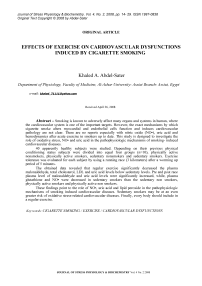Effects of exercise on cardiovascular dysfunctions induced by cigarette smoking
Автор: Khaled A. abdel-sater
Журнал: Журнал стресс-физиологии и биохимии @jspb
Статья в выпуске: 2 т.4, 2008 года.
Бесплатный доступ
Abstract - Smoking is known to adversely affect many organs and systems in human, where the cardiovascular system is one of the important targets. However, the exact mechanisms by which cigarette smoke alters myocardial and endothelial cells function and induces cardiovascular pathology are not clear. There are no reports especially with nitric oxide (NO), uric acid and hemodynamics after acute exercise in smokers up to date. This study is designed to investigate the role of oxidative stress, NO and uric acid in the pathophysiologic mechanisms of smoking- induced cardiovascular diseases. 40 apparently healthy subjects were studied. Depending on their previous physical conditioning status subjects were divided into equal four groups (n=10), physically active nonsmokers, physically active smokers, sedentary nonsmokers and sedentary smokers. Exercise tolerance was evaluated for each subject by using a running race (3 kilometers) after a worming up period of 5 minutes. The obtained data revealed that regular exercise significantly decreased the plasma malonaldehyde, total cholesterol, LDL and uric acid levels below sedentary levels. Pre and post race plasma level of malonaldehyde and uric acid levels were significantly increased, while, plasma glutathione and NO were decreased in sedentary smokers than the sedentary non smokers, physically active smokers and physically active non smokers. These findings point to the role of NO, uric acid and lipid peroxide in the pathophysiologic mechanisms of smoking induced cardiovascular diseases. Sedentary smokers may be at an even greater risk of oxidative stress-related cardiovascular diseases. Finally, every body should include in a regular exercise.
Cigarette smoking, exercise, cardiovascular dysfunctions
Короткий адрес: https://sciup.org/14323464
IDR: 14323464
Текст научной статьи Effects of exercise on cardiovascular dysfunctions induced by cigarette smoking
Cigarette smoking is a well known risk factor for cardiovascular diseases. This may be result of structural and functional changes in cardiovascular and pulmonary system (Lopez et al., 2008). There is a mechanistic link between increased levels of oxidative stress associated with smoking and the onset and progression of cardiovascular diseases (Bloomer et al., 2007). Moreover, smokers were associated with decreased of antioxidant capacity (Kemal et al., 2005). Supplementation with antioxidants can reduce symptoms and indicators of oxidative stress as a result of smoking (Gomez-Cabrera et al., 2006).
Free radicals are present in both tar and gas phases of cigarette smoke. The tar phase of cigarette contains semiqinone radical which can react with oxygen to produce superoxide anion, hydroxyl radical and hydrogen peroxide (Janet et al., 2003). The gas phase contains alkyl and peroxyl type (Pryor et al., 1998). In one puff of cigarette, the smoker is exposed to more than 1015 free radicals in gas phase alone, with addition exposure in the tar phase equal to more than 1017 free radicals per gram (Pryor and Stone, 1993).
Smoking is associated with increased of lipid, protein and DNA oxidation (Kirkham et al., 2004). The increased risk of cardiopulmonary diseases and atherosclerosis in cigarette smokers has been attributed in part to increased oxidation of lipid and protein (Ambrose and Barua, 2004). Oxidized DNA has been implicated in lung, breast and colorectal cancer (Cavalieri et al., 2000).
Nitric oxide (NO•) is a small molecule which has been implicated in a variety of physiological processes. One of its more important functions involves the dilatation of blood vessels. NO• is also involved in the thinning of the blood by decreasing the stickiness of blood platelet cells. This process decreases the chance of atherosclerosis and strokes (Guo et al., 2006).
Regular physical activity such as walking, aerobic exercise, running and sports are associated with beneficial changes in hemodynamic, metabolic, hormonal, neurological and cardiopulmonary functions. Body weight, lipid profiles, blood pressure, insulin sensitivity and coagulation parameters are examples of these changes (Ming et al., 1999). Despite of many health benefits of exercise, there are a lot of evidences suggesting that acute exercise is 100 folds increase in maximal oxygen consumption (Villa- Caballero et al., 2007).
Each of physical performance and plasma uric acid level is an important predictor of cardiovascular mortality (Niskanen et al., 2004 and Mora et al., 2007).
The association between cigarette smoking and vascular diseases is well documented, and there is a general consensus that it targets the vascular endothelial cells. However, the exact mechanisms by which cigarette smoke alters endothelial cells function and induces cardiovascular pathology are not clear.
To my knowledge, only two investigators has been performed to date to study the combined effects of cigarette smoking and exercise on oxidative stress (Surmen-Gur et al., 1999 and Bloomer et al., 2007). These investigators were used other mode of exercise, other personal selection and other methodology. There are no reports especially with nitric oxide, uric acid and hemodynamics after acute exercise in smokers up to date. Therefore, this study was designed to; 1) investigated the effects of single acute exercise on hemodynamics and oxidative stress in smokers, 2) estimation of physical and cardiopulmonary fitness (by duration of exercise and hemodynamic response) after acute exercise in sedentary and physically active smokers and 3) estimation of vascular fitness (by NO•, lipid profiles, lipid peroxidation and uric acid levels) after acute exercise in sedentary and physically active smokers.
SUBJECTS AND METHODS
40 apparently healthy subjects were studied. They were selected for age (20- 26 years), sex (males), weight (60-70 kg) and height (165-175 cm). All subjects complete a detailed medical history questionnaire and underwent a physical examination [weight, height, heart rate (HR), systolic blood pressure (SBP), diastolic blood pressure (DBP) and respiratory rate (RR)]. Exclusion criteria were the presence of cardiac diseases, pulmonary diseases, renal impairment, hypertension or diabetes documented from medical history and / or examination. Additionally, medical history indicated that participants did not use medications (e.g. antiinflammatory or cardiovascular drugs) or nutritional supplements (e.g. antioxidants). This was an important consideration, as intake of antioxidant agents could have impacted my outcome measures.
Men were labeled as physically active if they exercised for at least 30 minutes twice weekly up to the level of dyspnea and sweating. They were sedentary if they not performing regular exercise during the prior year (Villa- Caballero et al., 2007). In addition, to qualify for smoker status, participants needed to regularly smoke at least five cigarettes/day for minimum of six months immediately before experiment without interruption. Participants were eligible to be enrolled as nonsmokers only if they had not smoked within the past year (Bloomer et al., 2007). All subject provided both verbal and writing informed consent prior to participating. Depending on their previous physical conditioning status subjects were divided into equal four groups (n=10) as followings:
1-Group I: Physically active nonsmokers.
2-Group II: Physically active smokers.
3-Group III: Sedentary nonsmokers.
4-Group IV: Sedentary smokers.
Exercise Protocol and Hemodynamic Measurements: Participants were instructed not to perform any activity during the 48 hours period preceding the experiment. Nonsmokers were instructed to avoid smoking locations and direct contact with smokers during last 48 hours before the experiment (Bloomer et al., 2007). Active smokers had refrained from smoking for more than 12 hours before this study in order to minimize effects of acute smoking on study measurements (Otsuka et al., 2001). Exercise tolerance was evaluated for each subject by using a running race (three kilometers) after a worming up period of five minutes. Participants were instructed and encouraged to exercise until exhaustion. Heart rate and respiratory rate were estimated by stethoscope directly on the chest five minutes before and after race. Blood pressure was measured by mercury sphygmomanometer 5 minutes before and after race.
Blood Sampling: Venous blood sample (five ml) was obtained -in heparinized tubes- from all groups five minutes before and after exercise after fasting for at least 12 hours. No hypoglycemia or secondary effects were observed in any participant after exercise and blood sampling. The concentration of glutathione is negligible in human plasma. Therefore, studies have predominantly measured glutathione in whole blood or red blood cells (Hughes et al., 1990). Samples were analyzed for whole blood glutathione as an indication of antioxidants using the method of Androson (1985). The remainder of whole blood was separated immediately by centrifugation at 1500 rpm for 15 minutes to plasma and stored at – 800C until used for measurements. Malonaldehyde, a measure of lipid peroxidation was analyzed using the method of Okhawa et al., (1979). Uric acid, a predictor of cardiovascular mortality and functions was measured by enzymatic cooler test (Grootveld and Halliwell, 1987). Assay of triglyceride, total cholesterol, HDL and LDL cholesterol were performed using plasma following standard enzymatic procedures as described by the reagent manufacturer (Bio Merieux, France) (Laura et al., 2007).
The measurement of plasma NO• is difficult because thisradical is poorly soluble in water and has a short half-life (10–60 s), but its half-life may be as long as 4 min. in the presence of oxygen (Bakan et al., 2002). For these reasons, the NO• itself can be determined only with difficulty and requires the handling of radioisotopes. In spite of this, the end products of the phenomena, nitrate and nitrite, are preferentially used in clinical biochemistry. Plasma nitrite plus nitrate levels were measured with use of the Griess reagent as described previously (Green et al., 1982).
Statistical Analysis of Experimental Data (Wister, 2000) : Statistical analysis was done using the computer program (prism). The quantitative data were presented in the form of mean ± standard error (mean ± SE). The significance of differences between mean values was determined using Student's " t " test.
Also correlation coefficients (r-value) were done. A P<0.05 was considered significant for all analyses.
RESULTS
Characteristics of subjects are presented in table 1. The subjects of the four groups were similar in age, weight and height. No other statistical demographic differences were detected between groups. Duration of smoking per year and number of cigarettes per day were similar in physically active and sedentary smokers.
There were differences in the hemodynamic response before and after exercise among the subjects. During the exercise, subjects of group I, II and III had a longer time on the race, in comparison to group IV subjects (16 ± 5.5, 21 ± 2.3 and 15 ± 1.9
min. versus 9 ± 1.3 min. respectively). Most of persons of group IV are not completed the race. In addition, group IV subjects had a higher heart rate, respiratory rate and arterial blood pressure than other group subjects. Mean heart rate was 148.2 ± 10 beat/ min. in sedentary smokers after exercise, whereas it was 99.5 ± 8, 115.1 ± 6 and 136.4 ± 2.3 in groups I, II and III respectively (table 2 ). Heart rate and systolic blood pressure levels were significantly increased after acute exercise in sedentary nonsmokers and sedentary smokers groups above pre acute exercise levels in the same group. There was a significant difference between pre and post respiratory rates in physically active smokers and sedentary groups.
Table 1: Demographic characteristics of subjects in the different groups:
|
Groups Parameters |
Group I |
Group II |
Group III |
Group IV |
|
Number |
10 |
10 |
10 |
10 |
|
Age (year) |
23.6± 1 |
22.2± 0.1 |
21.2 ± 0.8 |
23±1 |
|
Weight (kg) |
62.7 ± 0.8 |
68.2± 2 |
60.3± 5 |
63.2± 0.5 |
|
Height (cm) |
169± 0.8 |
167.4± 0.5 |
162.2± 2 |
161.1± 4 |
|
Duration of smoking (year) |
7.4 ±1.1 |
NA |
6.6 ±1 |
NA |
|
Number of cigarettes (day) |
12± 5 |
NA |
8±2 |
NA |
Each value represents the mean ± SE. NA, not applicable.
No statistical differences were noted between groups for any of the above variables (p< 05)
Table 2: Hemodynamic response to acute exercise in physically active and sedentary smokers and nonsmokers:
|
Groups Parameters |
Group I |
Group II |
Group III |
Group IV |
||||
|
Pre race |
Post race |
Pre race |
Post race |
Pre race |
Post race |
Pre race |
Post race |
|
|
Duration of exercise (min) |
16 ± 5.5 |
21 ± 2.3 |
15 ± 1.9 |
9 ± 1.3 |
||||
|
Heart rate (beats/ minute |
72.3 ± 7.1 |
99.5 ± 8.0 ≠ • |
80.6 ± 5.5 |
115.1 ± 6.0* |
85 ±8.0† |
136.4 ± 2.3* |
102± 9.7*† |
148.2 ± 10.0* ≠ |
|
Systolic blood pressure (mmHg) |
110.3 ± 9.0 |
134.5 ± 10.2 ≠ • |
122.2 ± 11.9 |
153.5 ± 15.5* |
110.9 ±18.0† |
160.8 ± 15.7* |
134.1 ± 17.4*† |
180 ± 13.4* ≠ |
|
Diastolic blood pressure (mmHg) |
74.2 ± 8.1 |
78.9 ± 10.0 ≠ • |
70.6 ± 10.6 |
85.1± 18.9* |
80.6 ± 12 |
90 ± 18.6* |
85.4 ± 14.4* |
100.1 ± 12.2* ≠ |
|
Respiratory rate (beats/ minute) |
12.0 ±2.0 |
25.6 ± 2.0 ≠ • |
14.0 ±3.0† |
28.9 ± 2.0* |
15.0 ± 5.0† |
30.2 ± 2.0* |
18.0 ± 3.0*† |
38.7 ± 2.0* ≠ |
Each value represents the mean ± SE. * Significantly different from group I. ≠ Significantly different from group II
Fig. (1): Heart rate (beat/min.)(mean ± SE) in the four different groups.
Fig. (2): Systolic blood pressure (mmHg.)(mean ± SE) in the four different groups.
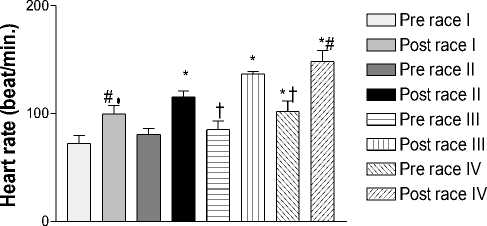
Groups

Fig. (3): Diastolic blood pressure (mmHg.)(mean + SE) in the four different groups.
Fig. (4): Respiratory rate (beat/min.)(mean + SE) in the four different groups.
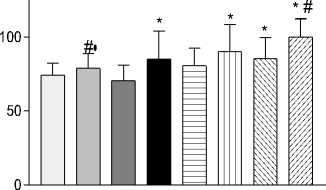
Groups
Е23 Post race IV
Post race II
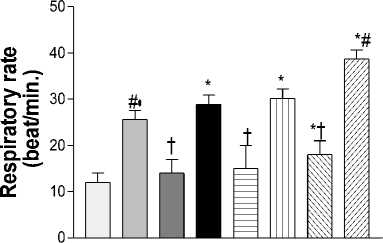
Groups
Fig. (5): Plasma triglyceride levels (mg %) (mean ± SE) in the four different groups.
Fig. (6): Plasma total cholesterol levels (mg %) (mean ± SE) in the four different groups.
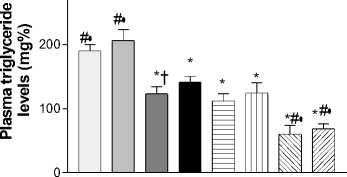
Groups
Pre race group I
Post race group I IZZI Pre race group II ■ Post race group II
Pre race group III mm Post race group III XXI Pre race group IV [XXXI Post race group IV

Groups
Fig. (7): Plasma HDL levels (mg%) (mean ± SE) in the four different groups.
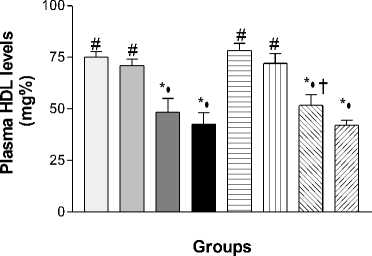
Pre race group I
Post race group I
Pre race group II ■ Post race group II
Pre race group III mm Post race group III [XXX Pre race group IV [XX] Post race group IV
Fig. (8): Plasma LDL levels (mg %) (mean ± SE) in the four different groups.
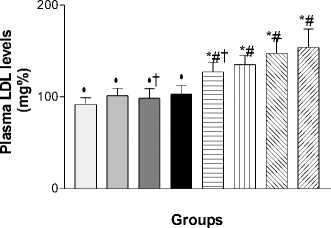
Fig. (9): Plasma malonaldehyde levels (µmol/ml)(mean ± SE) in the four different groups.
Fig. (10): Plasma glutathione levels (n mol/ml) (mean ± SE) in the four different groups.
1.00
0.00
0.75
0.50
0.25
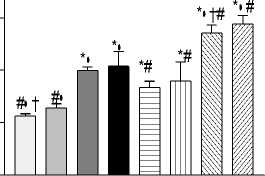
Groups
Pre race group I □ Post race group I □ Pre race group II ■ Post race group II El Pre race group III ШШ Post race group III El Pre race group IV ЕЕ Post race group IV
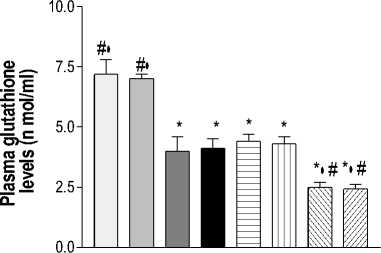
Groups
Table 3: Plasma lipid profile levels (mg %) after acute exercise in physically active and
|
sedentary smo |
kers and nonsmokers: |
|||||||
|
Groups Parameters |
Group I |
Group II |
Group III |
Group IV |
||||
|
Pre race |
Post race |
Pre race |
Post race |
Pre race |
Post race |
Pre race |
Post race |
|
|
Triglyceride |
190.4 ± 9.28 # • |
206 ± 17.2 # • |
123 ± 11.38*† |
141 ± 9.02* |
112 ± 15.9* |
124 ± 16.61* |
60 ± 14.1* # • |
68 ± 8.6* # • |
|
Total cholesterol |
107.8 ± 3.32 # • |
109.2 ± 11.6 # • |
162 ± 18.28*† |
174 ± 13.6* |
186.4 ± 20.07* |
190.4 ± 22.9* |
292.2 ± 9.91* # • |
304.2 ± 14.75* # • |
|
HDL |
75.21 ± 2.61 # |
71 ± 3.2 # |
48.40 ± 6.69*• |
42.6 ± 5.5*• |
78.40 ± 3.4 # |
72 ± 4.8 # |
42 ± 2.58*•† |
41 ± 2.58*• |
|
LDL |
91.8 ± 7.18• |
101.3 ± 8.04• |
127.20 ± 10.5•† |
103.1 ± 9.32• |
120.2 ± 10.5* # † |
135 ± 10.2* # |
154 ± 16.9* # |
155 ± 16.9* # |
Table 4: Oxidative stress profiles, nitric oxide and uric acid levels after acute exercise in physically active and sedentary smokers and nonsmokers:
|
Groups Parameters |
Group I |
Group II |
Group III |
Group IV |
||||
|
Pre race |
Post race |
Pre race |
Post race |
Pre race |
Post race |
Pre race |
Post race |
|
|
Malonaldehyde (µmol/ml) |
0.28 ± 0.01 # •† |
0.32 ± 0.02 # • |
0.49 ± 0.01*• |
0.52 ± 0.07*• |
0.41 ± 0.02* # |
0.45 ± 0.09* # |
0.67 ± 0.03* # •† |
0.72 ± 0.04* # • |
|
Glutathione (n mol/ml) |
7.2 ± 0.6 # • |
7 ± 0.2 # • |
4 ± 0.6* |
4.12 ± 0.39* |
4.4 ± 0.3* |
4.3 ± 0.2* |
2.5 ± 0.2* # • |
2.42 ± 0.20* # • |
|
Uric acid (mg %) |
1.6 ± 0.6 # • |
1.97 ± 0.27 # • |
2.83 ± 0.24*• |
3 ± 0.17*• |
4.33 ± 0.56* # † |
5.16 ± 0.24* # |
7.50 ± 0.85* # •† |
8.36 ± 0.43* # • |
|
NO• (µmol/ml) |
183.3 ± 3.68 # • |
178.3 ± 5.15 # • |
160 ± 8.5*•† |
153.3 ± 8.81*• |
129.4 ± 11.5* # † |
122.8 ± 8.30* # |
77 ± 8.95* # • |
76 ± 7.31* # • |
Each value represents the mean ± SE.
* Significantly different from group I.
# Significantly different from group II.
• Significantly different from group III.
† Significantly different from post race in the same group
The obtained data revealed that regular exercise significantly decreased the plasma malonaldehyde, total cholesterol, LDL and uric acid levels below sedentary levels. Pre and post race plasma levels of malonaldehyde and uric acid were significantly increased, while, plasma glutathione and NO• were significantly decreased in sedentary smokers than the sedentary non smokers, physically active smokers and physically active non smokers (tables 3 and 4).
Plasma malonaldehyde, uric acid and total cholesterol levels of sedentary smokers pre and post race were significantly increased above physically active nonsmokers, physically active smokers and sedentary non smokers levels. Significant increase of plasma LDL level was observed between sedentary smokers pre and post race and physically active non smokers and physically active smokers levels.
Sedentary smokers pre and post race produce significant decrease of plasma glutathione, NO• and triglyceride levels below physically active nonsmokers, physically active smokers and sedentary non smokers levels. Significant decrease of plasma HDL level was observed between sedentary smokers pre and post race levels and physically active nonsmokers and sedentary non smokers levels.
The obtained data in the present work clearly demonstrated that the post race plasma malonaldehyde and uric acid levels in sedentary smokers were significantly increase above levels of pre race in the same groups. There was a significant difference between pre and post malonaldehyde levels in physically active nonsmokers. Physically active smokers after acute exercise produce significant increase of plasma triglyceride and total cholesterol levels above pre race levels in the same group. While, it produces significant decrease of plasma NO• and LDL levels below pre race in the same group also. After acute exercise, sedentary nonsmokers produce significant increase of plasma LDL and uric acid above before exercise levels in the same groups. While, it produces significant decrease of plasma NO• levels below pre race levels in the same group also.
There was a positive correlation between plasma cholesterol level and each of uric acid level and malonaldehyde level in sedentary smokers (r=0.89; p<0.042 and r=0.92; p<0.022 respectively). Moreover, a significant positive correlation was observed between serum NO∙ and triglyceride in sedentary smokers (r= 0.92; p<0.027).
DISCUSSION
The present study confirms numerous positive effects of regular exercise over cardiovascular conditioning in smokers (William et al., 2002; Jonathan, 2003; Viitala et al., 2004; Kerry et al., 2005; Magkos et al., 2006; Raul, 2006; Villa-Caballero et al., 2007; Gomez-Cabrera et al., 2008; Radak et al., 2008 and Sachdev and Kelvin, 2008).
Individuals who were engaged in regular physical activity demonstrated lower cholesterol, LDL and uric acid levels and better general hemodynamic, triglyceride, HDL and nitric oxide levels pre and post race than sedentary individuals. This is the first study to my knowledge to report lipid profiles, uric acid and nitric oxide after acute exercise in physically active and sedentary smokers. The present findings provide additional insight into another possible mechanism associating cigarette smoking with ill health and disease.
Regular exercise has several protective mechanisms including decreased myocardial oxygen demand, increased myocardial oxygen supply, reduced propensity toward ventricular arrhythmias, reduced platelet aggregation, improved lipid profile, and increased plasma fibrinolytic activity (Leeuwenburgh and Heinecken, 2001).
Most of cardiovascular effects of smoking were due to stimulation of sympathetic and generation of oxidative stress. The acute effects of smoking are caused mainly by nicotine, which is absorbed very rapidly and enter the circulation. It stimulates directly the sympathetic nervous system, increasing the secretion of catecholamines from the medullary area of the suprarenal glands, stimulates the cerebral cortex and the hippocampus, the chemoreceptors of the aorta and the carotid arteries. The produced effects are vasoconstriction, reduced oxygen tension,
10.0
0.0
Fig. (11): Plasma uric acid levels (mg %) (mean ± SE) in the four different groups.
7.5
5.0
2.5
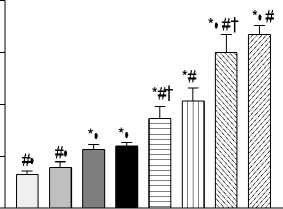
Groups
Fig. (12): Plasma nitrite plus nitrate levels (µmol/ml) (mean ± SE) in the four different groups.
□ Pre race I □ Post race I
□Pre race II ■ Post race II
Pre race III mm Post race III ЕЗ Pre race IV ЕТЗ Post race IV
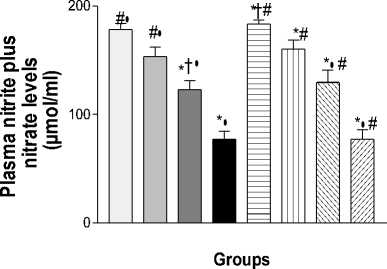
Table 5: Correlation between tested parameters levels in sedentary smokers group:
|
Tested parameter |
Triglycerides |
Total cholesterol |
Malonaldehyde |
Uric acid |
NO• |
|
Triglycerides |
R= 0.92 p<0.027 |
||||
|
Total cholesterol |
R=0.92 p<0.022 |
R=0.89 p<0.042 |
|||
|
Malonaldehyde |
r=0.92 p<0.022 |
||||
|
Uric acid |
R=0.89 p<0.042 |
||||
|
NO• |
R= 0.92 p<0.027 |
Fig. (13): Correlation between plasma total cholesterol level and malonaldehyde level in sedentary smokers
1.00
Ф тз > с ® ,
” ф- 0.75 Ф с > ■ ф -С — — ф о 0.50 .
Е го Э 0) с ГО о 0.25 О. <0
Е 0.00 "1---------------------1---------------------1--------------------- 1--------------------- 1
0 100 200 300 400
Plasma total cholesterol level (mg%)
Fig. (14): Correlation between plasma total cholesterol level and uric acid level in sedentary smokers
"О о го о

Ф > 8
ГО
6225 250 275 300 325 350
plasma total cholesterol level (mg%)
Fig. (15): Correlation between plasma triglyceride level and NO • level in sedentary smokers
Plasma triglyceride level (mg%)
increase of the arterial blood pressure and increase of the cardiac output (Antonio et al., 2008). The smaller stroke volume at all levels of exercise despite of the sympathetic stimulation caused by smoking, could represent an added negative inotropic effect on myocardium or be due to decrease in venous return, causing a compensatory increase in heart rate (William et al., 2002).
Regardless the mechanism, the net effect of smoking is to decrease the efficiency of the heart during exercise in the upright position by causing a smaller stroke volume and higher rate at any given level of exercise. Since the major hemodynamic effects of physical training are to increase the stroke volume over pre training levels, cigarettes can thus to said to produce change in opposite direction of those of physical conditioning. So, the stopping from acute exercise in smokers is due to inability of the heart to increase its stroke volume and cardiac out put volume up to need in normal fashion. After smoking, the heart becomes less efficient as a pump and requires more energy to do the same amount of work in non smokers (Kerry et al., 2005).
Decreased of exercise performance in smokers may be also due to rapid dyspnea that may be due to 1) constriction of the terminal bronchioles of the lungs, which increases the resistance of airflow into and out of the lungs. 2) The irritating effects of the smoke itself cause increased fluid secretion into the bronchial tree, as well as some swelling of the epithelial linings and 3) nicotine paralyzes the cilia on the surfaces of the respiratory epithelial cells that normally beat continuously to remove excess fluids and foreign particles from the respiratory passageways (Guyton and Hall, 2006).
The primary mechanism for the increase of blood pressure and heart rate during acute exercise is thought to be central neural output to cardiovascular control centers (Nathan et al., 2008). The difference between physically active smokers and sedentary smokers can be explained by high reactivity in parasympathetic tone caused by regular exercise in physically active subjects. This effect is known as post exercise hypotension and it may persistent up to 16 hours after an exercise bout (Villa- Caballero et al., 2007).
There are several interacting homeostatic regulators of blood pressure, including the renninangiotensin system, the autonomic nervous system, and local mediators. The myogenic tone and flowdependent vasodilatation are of major importance for the regulation of blood pressure under various physiological circumstances. The increase of arterial pressure in smokers may be due to decrease of NO• production. (Guo et al., 2006). Another mechanism may be due to decrease the blood insulin level and improve the insulin sensitivity by exercise that is one of important cause of hypertension in smokers (Peter et al., 1995).
Cigarette smoke–induced endothelial dysfunction is multifactorial may be secondary to oxidative stress generated by xanthin oxidase, increased of bad lipoprotein, and /or decrease of nitric oxide levels. Xanthin oxidase uses molecular oxygen as the electron acceptor, generating the superoxide radicals as a by product likely contributing to oxidative stress during exercise (Nishino et al., 2005). Acute exercise may require an increase in activity of adenylate cyclase and myokinase in muscle (Brooks et al., 2000) acting an additional source of energy by producing 1 ATP and 1 AMP while ATP is used for energy; the AMP is degraded to 1 MP. 1MP is catabolized to hypoxanthin to xanthin and finally to uric acid (Shlomit et al., 2003). Increased of uric acid is also associated with cardiovascular diseases (Niskanen et al., 2004). Recently, Anoop et al. (2008) reported that the association between plasma uric acid and cardiovascular disease and mortality may be mediated by its effect on subclinical atherosclerosis.
There is a general consensus that smoking targets the vascular endothelial cells. NO• is primarily responsible for vasoregulatory and homeostatic functions of endothelial cells. In the vitro model, cigarette smoking was associated with reduced NO• synthases activity as well as decreased NO• production (Wang et al., 2000). Components of cigarette smoke can react with L-arginine to form an L-arginine adduct. This reaction may have two possible effects. First, it may decrease the amount of L-arginine in the body and thus, less NO• is produced since there is less of its precursor. Secondly, the adduct formed may bind to the NOS itself and inhibit its function (Wong, 1999). Another possible mechanism is reactive oxygen species depress NO• synthesis through their inhibitory effect on endothelial receptors for acetylcholine and other vasodilators, while they directly react with NO• to form peroxynitrite, decreasing in this way NO• bioavailability (Laursen et al., 2001).
Raveendran et al., (2005) reported that cigarette smoke can induce excessive apoptosis in endothelial cells and other cell types. This apoptosis may be mediated by the activation of p38 MAPK (mitogen activated protein kinase), JNK/SAPK (Jun kinase kinase/ stress activated protein kinase) and caspases. Endogenous NO• production may be an important protective mechanism against smoking-induced endothelial damage. The decrease in NO• bioavailability in vessel wall stiffness may explain why smoking is an important risk factor for coronary artery disease (Guo et al., 2006).
Numerous authors have reported increased resting oxidative stress in cigarette smokers (Leeuwenburgh and Heinecken, 2001; Dietrich et al., (2003); Polidori et al., 2003; Kirkham et al., 2004; Muscat et al., 2004; Aycicek et al., 2005 and Bloomer et al., 2007). Likewise, an equal or greater number of investigations have reported elevations in protein, lipid and DNA oxidation following acute exercise (Shlomit et al., 2003; Orhan et al., 2004; Fatouros et al., 2004; Kemal et al., 2004; Viitala et al., 2004; Nishino et al., 2005; Russell et al., 2005; Gomez-Cabrera et al., 2006; Bloomer et al., 2007 Villa-Caballero et al., 2007 and Packer et al., 2008). Some studies (Surmen-Gur et al., 1999 and Alessio et al., 2000) have found little, or no, change in detectable malonyldialdehyde values in smoking and acute exercise. The exact reason for this is unknown but its may be due to methodical variation between studies or even the very nature of malonyldialdehyde detection. It may also be due to the rapid clearance of malonyldialdehyde from plasma (Dixon et al., 2006) and which can make it difficult to obtain accurate in vivo measurements of malonyldialdehyde (Sachdev and Kelvin, 2008).
Free radicals were generated in smokers from several source; 1) the mitochondria, from which oxygen radicals that have escaped scavenging enzymes present in mitochondria may leak into the sarcoplasm, 2) the capillary endothelium by xanthin oxidase, where a hypoxia or reoxygenation process is created during exercise (Kemal et al., 2004) and 3) an oxidative burst from inflammatory cells mobilized and activation of xanthin oxidase as a result of muscle or tissue ischemia and damage. Smoking was associated with the influx of neutrophils into the air spaces and alterations in oxidant antioxidant balance in the plasma and in air space, suggesting increased oxidant stress (Bloomer et al., 2007).
Acute exercise is postulated to generate free radicals by following mechanisms, 1) by mitochondria, electron leak from the mitochondrial electron transfer chain results in the production of superoxide anions (Cadenas and Davies, 2000). 2) By xanthine oxidase, with intensive exercise, certain regions of the body can face temporary periods of hypoxia- and ischemia-like conditions. In this state, xanthine dehydrogenase (an enzyme that functions by reducing NAD+) can be converted to xanthine oxidase, which functions by reducing molecular oxygen. ATP catabolism results in production of hypoxanthine, thereby producing substrate for xanthine oxidase. When oxygen is reintroduced (reperfusion) xanthine oxidase produces superoxide and hydrogen peroxide as by-products, contributing to overall oxidant and free radical formation (Nishino et al., 2005). 3- By neutrophils and other phagocytes as part of a heightened and extensive immune response to tissue injury with the subsequent production of free radicals by NADPH oxidase (Morozov et al., 2006). 4) By increases of catecholamines that can produce oxygen radicals when they are metabolically inactivated (Manuela et al., 2007). 5) By muscle mitochondria undergo increased uncoupling and superoxide generation with increasing temperatures. Therefore exercise-induced hyperthermia may cause oxidative stress (Christopher and David, 2003). 6) By production of lactic acid that converts a weakly damaging free radical (superoxide) into strongly damaging one (hydroxyl) (Clarkson and Thomposon, 2000). 7) By depletion of thiols and an increase of intracellular Ca++ may potentate free radical generation in acute exercise (Willium and Donald, 2000). 8) By auto-oxidation of oxyhemoglobin to methemoglobin results in the production of superoxide (Willium and Donald, 2000).
Ji et al. (1993) examined the mechanism of the change in glutathione in the blood in response to exercise. They found that when subjects performed the same exercise but ingested carbohydrate, sufficient to increase blood glucose and insulin over the control condition, there was no increase in glutathione. The increased of glutathione by regular exercise may be due to hepatic glutathione efflux by glucagon.
It is very clear that regular exercise training induces adaptive responses that permit improved exercise performance (Sachdev and Kelvin, 2008).These adaptive responses include reduced basal production of oxidants, reduction of radical leak during oxidative phosphorylation, increased the activity of antioxidant enzymes and increased oxidative damage repair systems to improved physiological function and enhanced resistance to oxidative stress (Radak et al., 2008). Exercise also has a large impact on the availability and bioactivity of endothelial-derived nitric oxide. The stimulus for endothelial NO• production is the increased flow through the vessels, which results in shear stress and increased activation of endothelial nitric oxide synthase (Kojda and Hambrecht, 2005).
CONCLUSION AND RECOMMENDATIONS:
These findings point to the role of NO∙, uric acid and lipid peroxide in the pathophysiologic mechanisms of smoking induced cardiovascular diseases. The free radicals are formed in excess in smokers especially after acute exercise. Sedentary smokers may be at an even greater risk of oxidative stress-related cardiovascular diseases. The significance of information obtained though this study is not only elucidation of the mechanism of smoking induced cardiovascular disease, but also provide a possible better method of treatment and diagnosis for smokers who have developed cardiovascular disease symptoms through the possibility of L-arginine, antioxidants, xanthine oxidase inhibitor replacement therapies. There is a need of more prospective studies regarding oxidative stress and diverse exercise types and regimens in smokers. Because the risk of cardiovascular morbidity and mortality appears greater within an aging population, future investigations should focus on older, more established smokers, while giving specific attention to the number and method of cigarettes smoked per day, to determine if more robust findings are noted. Finally, every body should include in a regular exercise.
Список литературы Effects of exercise on cardiovascular dysfunctions induced by cigarette smoking
- Alessio H.; Hagerman A.; Fulkerson B.; Ambrose J.; Rice R. and Wiley R. (2000): Generation of reactive oxygen species after exhaustive aerobic and isometric exercise. Med. Sci. Sports Exerc., 32: 1576-1581.
- Ambrose J. and Barua R. (2004): The pathophysiology of cigarette smoking and cardiovascular disease: An update. Journal of American Collage of Cardiology, 43: 1731-1737.
- Anderson M. (1985): Determination of glutathione and glutathione disulfide in biological samples. Met. Enzymol., 113: 548-555.
- Anoop S.; Barbara E.; Javier N. and Ronald K. (2008): Association between serum uric acid level and peripheral arterial disease. Atherosclerosis, 196: 749-755.
- Antonio C.; Raffaele M.; Andrea L.; Manuela C.; Filippo T.; Alberto C. and Franco M. (2008): Haemodynamic effect of metaboreflex activation in men after running above and below the velocity of the anaerobic threshold. Experimental Physiology, 93 (4): 447-457.
- Aycicek A.; Ozcan E. and Abdurrahim K. (2005): Decreased total antioxidant capacity and increased oxidative stress in passive smoker infants and their mothers. Pediatrics International, 47 (6): 635-639.
- Bakan E.; Seyithan T.; Fevzi P.; Sabahattin D.; Zuhal U.; Nuri B. and Metehan G. (2002): Nitric oxide levels and lipid peroxidation in plasma of patients with gastric Cancer. Japanese Journal of Clinical Oncology, 32: 162-166.
- Bloomer J.; Creasy A. and Smith W. (2007): Physical work-induced oxidative stress is exacerbated in young cigarette smokers. Nicotine and Tobacco Research, 9 (2): 205-211.
- Brooks G.; Fahey T.; White T. and Baldwin K. (2000): Exercise physiology human bioenergetics and its applications. Mountain View, Mayfield publishing company.
- Cadenas E. and Davies K. (2000): Mitochondrial free radical generation, oxidative stress, and aging. Free Radic. Biol. Med., 29: 222-230.
- Cavalieri E.; Frenkel K.; Rogan E.; Roy D. and Liehr J. (2000): Estrogen as endogenous genotoxic agent: DNA adducts and mutations. J. Natl. Cancer Inst., 27: 75-93.
- Christopher M. and David J. (2003): Exercise-associated oxidative stress. Clinical Techniques in Equine Practice, 2 (3): 278-291.
- Clakson M. and Thompson H. (2000): Antioxidants: what role do they play in physical activity and health?. American journal of clinical nutrition, 72 (2): 637S-646S.
- Dietrich M; Block G.; Norkus P.; Hudes M.; Traber M.; Cross E.; Packer L. (2003): Smoking and exposure to environmental tobacco smoke decrease some plasma antioxidants and increase gamma-tocopherol in vivo after adjustment for dietary antioxidant intakes. Am. J. Clin. Nutr., 77(1): 160-166.
- Dixon C.; Robertson R.; Goss F; Timmer J.; Nagle E. and Evans R. (2006): The effect of acute resistance exercise on serum malondialdehyde in resistance-trained and untrained collegiate men. J. Strength Cond. Res., 20: 693-698.
- Fatouros I.; Jamurtas A.; Villiotou V.; Pouliopoulou S.; Fotinakis P.; Taxildaris K. and Deliconstantinos G. (2004): Oxidative stress responses in older men during endurance training and detraining. Med. Sci. Sports Exerc., 36: 2065-2072.
- Gomez-Cabrera M.; Martinez A.; Santangelo G.; Pallardo F.; Sastre J. and Vina J. (2006): Oxidative stress in marathon runners: interest of antioxidant supplementation. Br. J. Nutr., 96 (1): S31-S33.
- Gomez-Cabrera M.; Domenech M. and Vica J. (2008): Moderate exercise is an antioxidant: Upregulation of antioxidant genes by training. Free Radical Biology and Medicine, 44: 126131.
- Green L.; Wagner D.; Glogowski J.; Skipper P.; Wishnok J. and Tannenbaum S. (1982): Analysis of nitrate, nitrite, and [15N] nitrate in biological fluids. Anal Biochem., 126: 131-138.
- Grootveld M. and Halliwell B. (1987): Measurement of allantoin and uric acid in human body fluids. A potential index of free-radical reactions in vivo?. Biochem. J., 243 (3): 803-808.
- Guo X.; Oldham M.; Kleinman M.; Phalen R. and Kassab G. (2006): Effect of cigarette smoking on nitric oxide, structural, and mechanical properties of mouse arteries. Am. J. Physiol. Heart Circ. Physiol., 291: H2354 -H2361.
- Guyton A. and Hall J. (2006): Effect of Smoking on pulmonary ventilation in exercise in: Textbook of medical physiology, 11th ed. Elsevier Inc., Philadelphia, Pennsylvania. pp1062.
- Hughes H; Jaeschke H. and Mitchell J. (1990): Measurement of oxidant stress in vivo. Methods Enzymol., 186: 681-685.
- Janet A.; Daniel R. and Howard B. (2003): Smoking progression and physical activity. Cancer Epidemiology Biomarkers & Prevention, 12: 1121-1129.
- Ji L.; Katz A.; Fu R.; Griffiths M. and Spencer M. (1993): Blood glutathione status during exercise: effect of carbohydrate supplementation. J. Appl. Physiol. 74 (2): 788-792.
- Jonathan M. (2003): Exercise and Cardiovascular Health. Circulation, 107: e2-e5.
- Kemal U.; Filiz G.; Oktay K.; Gьnnur K.; Yasar G.; Akin Y.; Melek B.; Murat Ь.; Цzlem Y. and Oguz K. (2005): Exercise-induced oxidative stress leads hemolysis in sedentary but not trained humans. J. Appl. Physiol., 99: 1434-1441.
- Kerry J.; Anita C.; Katherine L.; Jerome L.; Paul S.; Edward P.; Matthew T. and Pamela O. (2005): Effect of Exercise on blood pressure in older persons. A randomized controlled trial. Arch. Intern. Med., 165: 756-762.
- Kirkham P.; Spooner G.; Rahman I. and Rossi A. (2004): Macrophage phagocytosis of apoptotic neutrophils is compromised by matrix proteins modified by cigarette smoke and lipid peroxidation products. Biochemical and Biophysical Research Communications, 318: 32-37.
- Kojda G. and Hambrecht R. (2005): Molecular mechanisms of vascular adaptations to exercise: Physical activity as an effective antioxidant therapy. Cardiovasc. Res., 67: 187-197.
- Laura R.; Sergio F.; Elisabetta C.; Alessandro M. and Paola F. (2007): Losartan ameliorates diabetic vascular hyper-reactivity to angiotensin II by reducing rock 1 expression and activity. J. Mol. Cell. Cardiol., 12: 34-40.
- Laursen J.; Somers M. and Kurz S. (2001): Endothelial regulation of vasomotion in apoE-deficient mice: Implications for interactions between peroxynitrite and tetrahydrobiopterin. Circulation, 103 (9): 1282-1288.
- Leeuwenburgh C. and Heinecken J. (2001): Oxidative stress and antioxidants in exercise. Current Medicinal Chemistrey, 8: 829-838.
- Lopez E.; Christopher R.; Dian O.; Weddle J. and Rahill M. (2008): The Relationship among Cardiovascular Risk Factors, Diet Patterns, Alcohol Consumption, and Ethnicity among Women Aged 50 Years and Older. J. Am. Diet. Assoc., 108: 248-256.
- Magkos F; David C.; Bruce W.; Selma M. and Bettina M. (2006): Lipid metabolism response to a single, prolonged bout of endurance exercise in healthy young men. Am. J. Physiol. Endocrinol. Metab., 290: E355-E362.
- Manuela G.; Xuejuan J. and Esteban J. (2007): Lipid peroxidation and the protective effect of physical exercise on breast cancer. Medical Hypotheses, 68: 1138-1143.
- Ming L.; Robert B.; Sari M.; Sanni L.; Miia V.; Hannele H.; Hannele Y. and Marja-Riitta T. (1999): A marathon run increases the susceptibility of LDL to oxidation in vitro and modifies plasma antioxidants. Am. J. Physiol. Endocrinol. Metab., 276: E1083-E1091.
- Mora S; Nancy C.; Julie E.; Paul M. and I-Min L. (2007): Physical activity and reduced risk of cardiovascular events, potential mediating mechanisms. Circulation, 116: 2110-2118.
- Morozov V.; Tsyplenkov P.; Golberg N. and Kalinski M. (2006): The effects of high-intensity exercise on skeletal muscle neutrophil myeloperoxidase in untrained and trained rats. Eur. J. Appl. Physiol., 97: 716-722.
- Muscat J.; Kleinman W.; Colosimo S.; Muir A.; Lazarus P.; Park J. and Richie J. (2004): Enhanced protein glutathiolation and oxidative stress in cigarette smokers. Free Radic. Biol. Med., 36(4): 464 -470.
- Nathan J.; Nalin A.; Dale A.; Theodora M.; Rhonda O. and Maria A. (2008): Continuous hemodynamic response to maximal dynamic strength testing in older adults. Archives of Physical Medicine and Rehabilitation, 89(2): 343-350.
- Nishino T.; Okamoto K.; Kawaguchi Y.; Hori H.; Matsumura T.; Eger B.; Pai E. and Nishino T. (2005): Mechanism of the conversion of xanthine dehydrogenase to xanthine oxidase: Identification of the two cysteine disulfide bonds and crystal structure of a non-convertible rat liver xanthine dehydrogenase mutant. J. Biol. Chem., 280: 24888-24894.
- Niskanen L.; Laaksonen D.; Nyyssцnen K.; Alfthan G.; Lakka H.; Lakka T.; Jukka T. (2004): Uric Acid Level as a Risk Factor for Cardiovascular and All-Cause Mortality in Middle-aged Men. Arch. Intern. Med., 164: 1546-1551.
- Okhawa H.; Ohishi N. and Yagi K. (1979): Assay for lipid proxides in animal tissues by thiobarbituric acid reaction. Anal. Biochem., 95: 351-358.
- Orhan H.; Van Holland B.; Krab B.; Moeken J.; Vermeulen N.; Hollander P. and. Meerman J. (2004): Evaluation of a multi-parameter biomarker set for oxidative damage in man: increased urinary excretion of lipid, protein and DNA oxidation products after one hour of exercise. Free Radic. Res., 38: 1269-1279.
- Otsuka R; Hiroyuki W.; Kumiko H.; Kotaro T.; Takashi M.; Minoru Y.; Kazuhide T. and Junichi Y. (2001): Acute effects of passive smoking on the coronary circulation in healthy young adults. JAMA, 286: 436-441.
- Packer L; Cadenas E. and Davies K. (2008): Free radicals and exercise: An introduction. Free radical biology and medicine, 44 (2): 123-125.
- Peter F.; Puneet N.; John A.; Andreas P.; Aldo N.; Domenic R. and Vasilios P. (1995): Effects of regular exercise on blood pressure and left ventricular hypertrophy in African-American men with severe hypertension. NEJM, 333 (22): 1462-146.
- Polidori M.; Mecocci P.; Stahl W. and Sies H. (2003): Cigarette smoking cessation increases plasma levels of several antioxidant micronutrients and improves resistance towards oxidative challenge. British Journal of Nutrition., 90(1): 147-150.
- Pryor W.; Stone K.; Zang L. and Bermudez E. (1998): Fractionation of aqueous cigarette tar extracts: fractions that contain the tar radical cause DNA damage. Chem. Res. Toxicol., 11: 441-448.
- Pryor W. and Stone K. (1993): Oxidants in cigarette smoke. Radicals, hydrogen peroxide, peroxynitrate, and peroxynitrite. Annals of the New York Academy of Sciences, 686: 12-27.
- Radak Z.; Young C. and Sataro G. (2008): Systemic adaptation to oxidative challenge induced by regular exercise. Free Radical Biology & Medicine, 44: 153-159.
- Raul J. (2006): Preconditioning: A new concept about the benefit of exercise. Circulation, 113: e1-e3.
- Raveendran M.; Jing W.; Duraisamy S.; Jian W.; Budi U.; Ying S.; Donald D.; Yun Z. and Xing L. (2005): Endogenous nitric oxide activation protects against cigarette smoking induced apoptosis in endothelial cells. FEBS Lett., 579(3): 733-740.
- Russell A.; Hesselink M.; Lo S. and Schrauwen P. (2005): Regulation of metabolic transcriptional co-activators and transcription factors with acute exercise, FASEB J., 19: 986-988.
- Sachdev S. and Kelvin J. (2008): Production, detection, and adaptive responses to free radicals in exercise. Free Radical Biology and Medicine, 44: 215-223.
- Shlomit C.; Danny S.; Yuval H.; Yoav S.; Gilad R.; Benny A.; Eduard B.; Earl R. and Yoram E. (2003): Plasma antioxidant status and cell injury after severe physical exercise. PNAS, 100 (9): 5119-5123.
- Surmen-Gur E.; Ozturk E.; Gur H.; Punduk Z. and Tuncel P. (1999): Effect of vitamin E supplementation on post-exercise plasma lipid peroxidation and blood antioxidant status in smokers: With special reference to haemoconcentration effect. European Journal of Applied Physiology and Occupational Physiology, 79: 472-478.
- Viitala P.; Newhouse I.; Norm L. and Christine G. (2004): The effects of antioxidant vitamin supplementation on resistance exercise induced lipid peroxidation in trained and untrained participants. Lipids in Health and Disease, 3: 14-18.
- Wang H.; Ye Y.; Zhu M. and Cho C. (2000): Increased interleukin-8 expression by cigarette smoke extract in endothelial Cells. Environ Toxicol. Pharmacol., 9: 19-23.
- William E.; Joseph A.; Brian D; Kenneth J.; Michelle B.; Jennifer S.; Connie W.; Sarah H.; Gregory P.; James D.; Krishnaji R. and Cris A. (2002): Effects of the Amount and Intensity of Exercise on Plasma Lipoproteins. NEJM, 347 (19): 1483-1492.
- William J. and Domald W. (2000): Vitamin E, vitamin C and exercise. American journal of clinical nutrition, 72 (2): S647-S652.
- Wister D. (2000): Biostatistics. 3rd ed., Jon Wiley & Sons, pp. 5-78.
- Wong P. (1999): Effect of tobacco smoke on nitric oxide synthesis. Tobacco related diseases research program. Award Cycle (cycle III).
- Zsolt R.; Hae Y.; Erika K.; Albert W. and Sataro G. (2008): Exercise, oxidative stress and hormesis, Ageing Research Reviews 7 (1): 34-42.

